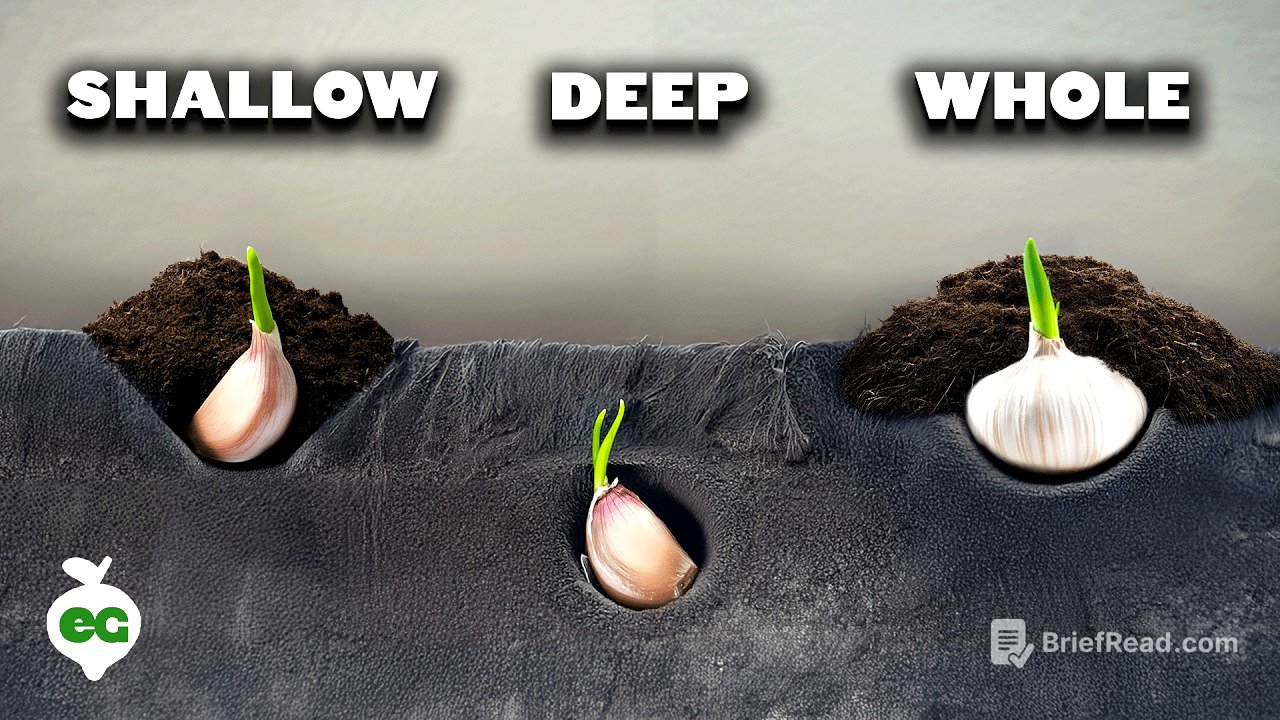TLDR;
Kevin and Jacques from Epic Gardening conduct an experiment to determine the best methods for growing garlic. They test various planting depths, spacing, clove sizes, and pre-planting treatments, comparing the results after two and six months. The key findings suggest that planting a whole bulb can yield a cluster of smaller garlic heads, tight spacing doesn't negatively impact bulb size, and planting tiny cloves results in smaller bulbs.
- Planting a whole garlic bulb yields a cluster of smaller, usable garlic heads.
- Tight spacing (3 inches) does not significantly reduce bulb size.
- Planting tiny cloves results in smaller garlic bulbs.
- Deep planting (6 inches) offers no advantage and makes harvesting difficult.
- Soaking cloves in fertilizer may improve initial growth but doesn't prevent diseases like garlic rust.
Intro [0:00]
Kevin and Jacques set out to determine the best way to grow the biggest and best garlic. Acknowledging garlic's popularity and the need for substantial harvests due to its long growing season (5-6 months), they plan to test seven different growing methods in uniformly prepared soil. The soil preparation includes loosening the soil with a broad fork, adding organic fertilizer, and incorporating compost. The experiment will use the same variety of garlic (music garlic) and pre-selected cloves of the same size to ensure consistency.
Methods Used [1:27]
The experiment includes a control method, which involves planting cloves 3 inches deep and spacing them 6 inches apart in rows that are 10 inches apart. Variations from this control include planting at a shallow depth of 1 inch and an extra deep depth of 6 inches, both with the same 6-inch spacing. Spacing variations include a tight 3-inch spacing and a wider 9-inch spacing, both at the standard 3-inch depth. Additionally, they test a sanitize and fertilizing soak, where cloves are soaked in a 3% hydrogen peroxide bath for 10 minutes, followed by a half-hour soak in organic liquid fertilizer, using standard depth and spacing. They also plant the smallest possible cloves at the control depth and spacing and bury an entire head of garlic at a 3-inch depth to see what happens. All experiments are set up with a consistent irrigation system.
2-Month Update [3:14]
After two months, differences are visible among the garlic plants. The shallow-planted garlic (1 inch deep) appears the most vigorous, while the control looks weaker. The deep-planted garlic has emerged, but its leaves erupted directly from the soil without a stem. The 3-inch spacing appears to have no negative impact, as the plants are not yet competing for space. The garlic grown from tiny cloves looks smaller and more wispy. The soaked cloves appear to be doing better than the control. Most notably, the whole bulb planting looks vigorous, potentially because it was not disrupted from its natural state.
Final Update [6:05]
After six months, the garlic is harvested and evaluated. The control produced modest garlic heads. The shallow-planted garlic yielded heads that were as good as or better than the control. The deep-planted garlic was difficult to dig up and showed no size advantage, suggesting deep planting is not beneficial. The garlic grown from tiny cloves produced smaller bulbs, confirming the expectation that smaller cloves yield smaller bulbs. The tightly spaced garlic (3 inches apart) produced solid heads, indicating that tighter spacing is viable, especially for small-time gardeners. The whole bulb planting yielded a cluster of smaller but well-separated garlic heads, which is considered a good yield for the space used. The soaked garlic appeared to have the best overall results, although all plants eventually developed garlic rust. The final recommendations include considering planting a whole bulb for fun, potentially doing a light soak, and using tighter spacing (3-4 inches). Deep planting and very shallow planting (1 inch) are not recommended due to the lack of advantages and potential stress on the plants.








![[여의도튜브] '희토류' 큰소리 치더니 "中, 재앙이 왔다" /머니투데이방송](https://wm-img.halpindev.com/p-briefread_c-10_b-10/urlb/aHR0cDovL2ltZy55b3V0dWJlLmNvbS92aS82dlMxeG9rN3Zzby9ocWRlZmF1bHQuanBn.jpg)
